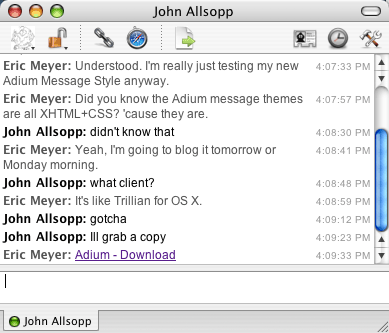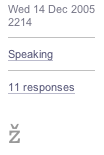Bread, Soup, and Love
Published 19 years, 11 months pastA couple of weeks before Christmas, Kat and I held our annual Bread and Soup Party. We started it the year we moved into our house, and it’s still going strong. We’re to the point now of luring attendees from other states: in the past, we’ve had people from New York, Illinois, and Oregon fly in to spend a long weekend and be at the party. Had you been there this year, you’d have gotten to meet Molly, as well as have a chance to video chat with Andy. We also got blogged here and there by attendees, all of whom seemed to have a great time. Our guess is that in the course of the party, close to 90 people passed through our doors. This is a good turnout, though well below our high of 150 from last year.
Why am I bringing this up? Because several people, upon hearing about this party from the bloggers and other guests, have expressed interest in holding their own version of the party. To which I say: hey, you slackers, come up with your own damn party idea!
I’m kidding. I kid! You should absolutely feel free to copy the idea, or come up with your own variant. Here’s the not-quite-a-recipe we follow for this event.
- We invite just about everyone we know, regardless of how close or far away they live. In fact, we put an invitation in the mailbox of every house on our block, and it’s a semi-lengthy block, so in many cases we’re inviting people we don’t know. That’s okay. The people we know are always welcome to bring people they know, but we don’t.
- The party has a start time, but no end time. The format is open house: people come when they can, and leave when they like. We start at 3:00pm on a weekend day, and usually the last guests are out the door by 9:00pm. The first year it went a bit later, and people still speak in hushed and shuddering tones of the “Truth or Dare Jenga” game that was played that night.
- The time of year is important. Bread and soup in the middle of summer doesn’t work nearly as well as it does in winter. Being in the Northern Hemisphere, which puts the holidays in winter, is a bonus, but not crucial.
- We state right on the invitation, and as many times as we can think to do so, that guests should bring nothing but themselves and some good cheer. No gifts, no bottle of wine, no food. We haven’t yet started a policy of turning away gift-bearers, but we’re considering it.
- Children are welcome. They were even before we had our own, but this is key if you want to draw families. Which we do.
- We get help from our friends. We have cooks beforehand, and a cleanup crew after. This is essential, because otherwise we’d never be able to manage it.
- We use paper plates—nice heavy laminated paper, but paper nonetheless—and styrofoam cups with plastic spoons for the soups. This makes cleanup a whole lot easier, plus it means we don’t have to buy place settings for 128, or worry about dropped bowls shattering. We’re seriously thinking about going to small styrofoam bowls next year, but the principles basically the same.
Okay, so those are the parameters. The content, though, is what brings ’em in: we provide five pots of soup and from five to seven loaves of bread, each one cooked entirely from scratch. Here’s this year’s lineup.
-
Soups:
- Sweet curry soup
- Black bean soup
- Tom yum goong (a hot Thai soup; recipe available over at The Obscurarium)
- Matzo ball soup
- Pumpkin soup
-
Breads:
- Cornbread
- Challah
- Eggnog bread
- Oatmeal bread
- Gingerbread (the real stuff, not the thin house-building kind)
To make things extra-tasty, we try to coordinate soups and breads. For example, this year we made gingerbread because it seemed like a good match for the pumpkin soup. (And wow, was it ever.) Similarly, the cornbread was an excellent partner to the black bean soup.
Remember: these are all cooked from scratch. The closest we’ve gotten to pre-made soup was the year we had clam chowder, when we bought the clams in cans. The breads are all done from first principles, even the cornbread, which is made with real cornmeal and not a bunch of boxes of Jiffy corn mix. Nothing wrong with Jiffy, which I love, but it just doesn’t yield the kind of hearty, rustic cornbread we were after.
This sounds like a lot of work, and it is, but that’s why I made the point about having friends help. In the past few years, we’ve set things up so that each pot of soup has its own sous chef. (This year, the soups were actually chefs’ choice, so that made them rather less sous-y, I admit.) Cooking starts around 10:00am, with all of us gathered in the kitchen chatting, laughing, tasting, and adjusting as we cook. It’s noisy and cozy and smells amazing, and honestly is more fun than the party itself, at least for us. It’s a shame that the cooking experience doesn’t scale up to a full party, or else we’d just do that.
In addition to the soups and breads, we also set up a cheese board with several different varities, crackers, summer sausages, and grape clusters. For drinks, we provide eggnog (both spiked and unspiked) and hot mulled apple cider; and for dessert, a selection of petit fours and candies. But those are reflections of our profound yuppiehood, and not really integral to the core party experience.
Once everyone’s left besides the cleanup crew, we start washing and storing any leftovers (this year, there were hardly any) and doing a post-mortem of which offerings were popular, and why. This stage is a lot quieter and more reflective than the cooking part, but it’s no less enjoyable.
I’ll throw open the comments to observations from guests from this and previous years, and questions from anyone who’s curious to know more.


